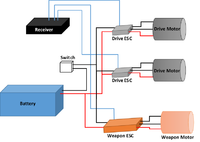Difference between revisions of "Electronics Basics"
| Line 20: | Line 20: | ||
'''Brushed vs Brushless ''' | '''Brushed vs Brushless ''' | ||
== ESCs == | == ESCs == | ||
| − | An ESC (Electronic Speed Control) receives | + | An ESC (Electronic Speed Control) receives a control signal from the reciever that dictates how much power to output to the motor. It then generates a 3 phase AC signal of the proper power from the battery and sends it to the motor. The ESCs adjust the phase of the output based on the motor rotation, which it measures using the back emf response from the motor. This allows the user to spin the motor at different speeds to control the speed and direction of the robot |
=== Choosing an ESC === | === Choosing an ESC === | ||
| + | ESCs are chosen based on the max current they will experience. Generally the ESC’s rated current should be higher than the motor’s rated current. | ||
== Batteries == | == Batteries == | ||
== Reciever == | == Reciever == | ||
Revision as of 22:14, 1 November 2018
Contents
Overview
Electronics are an important consideration of all Combat bots. Robots without strong electronics can suffer from shorts and over-voltage, which can ruin components and disable the robot. Creating a strong electrical system is crucial to increasing the durability and maximizing the damage output of the robot. Additionally, compact electronics allow the designer to decrease the size and footprint of the robot,
3lb Circuit
The standard 3lb electrical layout consists of a 1000 mAh 11.1 V battery connected to a mechanical switch, which powers 2 drive ESCs and a Weapon ESC. The ESCs are each connected to a receiver and send power to the motors in 3 phases.
Parts List
- 1000mAh 11.1V Battery
- Drive ESCs
- Drive Motors
- Switch
- Receiver
Motors
Choosing a Motor
Types
Inrunner vs Outrunner
Brushed vs Brushless
ESCs
An ESC (Electronic Speed Control) receives a control signal from the reciever that dictates how much power to output to the motor. It then generates a 3 phase AC signal of the proper power from the battery and sends it to the motor. The ESCs adjust the phase of the output based on the motor rotation, which it measures using the back emf response from the motor. This allows the user to spin the motor at different speeds to control the speed and direction of the robot
Choosing an ESC
ESCs are chosen based on the max current they will experience. Generally the ESC’s rated current should be higher than the motor’s rated current.
